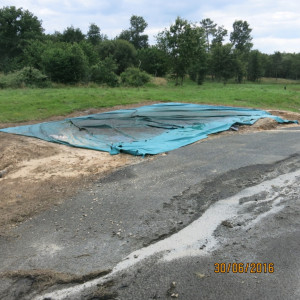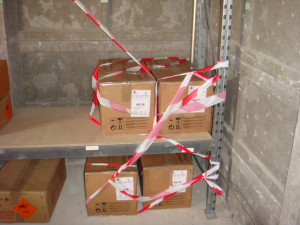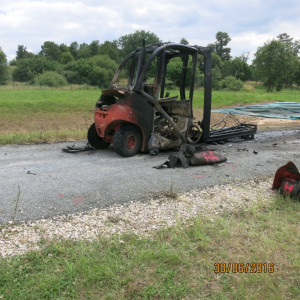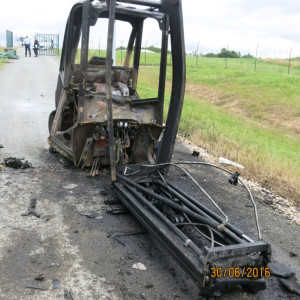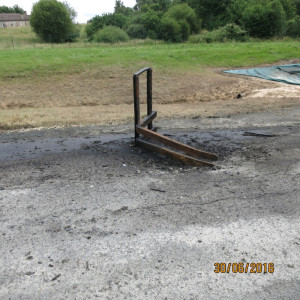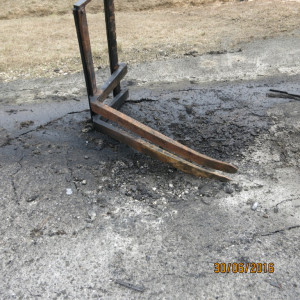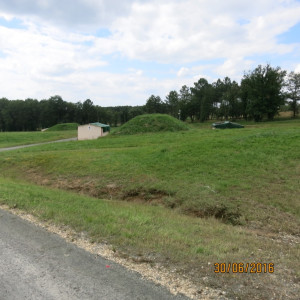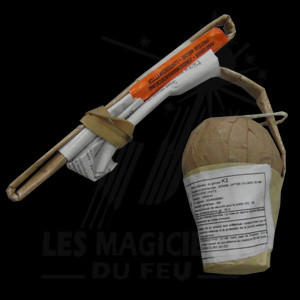An explosion occurred at 3:35 p.m. at a pyrotechnics storage site. The site manager was using a forklift truck to transfer explosive materials between the loading/unloading bay and one of the warehouses. He was killed on the spot. A second worker nearby was also killed.
Two workers who had left the site a few minutes before the events turned around after hearing the explosion and observed the release of a plume of white smoke (mushroom). They raised the alarm. The internal emergency plan was launched. Firemen put out the fire on the forklift.
The body of the site manager was found beside the forklift. That of the second worker was found further down from the site of the explosion, having probably been moved when a 120 m³ water tank burst.
A crater 1 m wide and 0.3 m deep was formed. The forklift was completely burned out and had been shifted back 5 m from the crater. Metal and plastic debris from the forklift was scattered across a radius of 30 m. The roofs of 2 warehouses 50 m away were damaged, presumably by the blast. There was no damage off site.
The 2 people who died were the only people present on site when the accident occurred. The site manager, who died in the accident, had worked there for 18 years. The second victim was a temporary worker who had been employed for the season.
The products being transported were maroons (fireworks) with a diameter of 75 mm, packaged in boxes authorised for transport (products in hazard division 1.1.). The active substances in the load (11 packages of 60 maroons each) totalled 89 kg: 66 kg of a mixture of potassium perchlorate and aluminium and 13 kg of gunpowder. The existence of a crater and the absence of any pallet or box debris confirm that a mass explosion occurred.
The inspection authorities for classified facilities noted several significant discrepancies:
- a forklift was used instead of the dedicated in-house vehicle for transferring products between the loading/unloading bay and the warehouses’ delivery area;
- the pallet on which the cartons were placed was not film-wrapped.
The route followed by the forklift was on a slope. A package appears to have fallen and been run over by the wheels of the forklift. There was then a friction/hotspot effect on the pyrotechnic substance that had spilled on the floor. This is based on the fact that the fork became detached from the forklift and the vehicle’s wheels were torn off and blown outwards around 20 m on each side. This configuration indicates that the initial load affected was probably under the forklift and that the explosion spread to the main load on the pallet.
Several other theories such as the pyrotechnic substance being unstable, pyrotechnic material leaking following a quality fault in a maroon, etc. have been discounted. Indeed, maroons from the same batch have been examined by experts without any anomaly in terms of stability or conformity being revealed. The products, which were manufactured by a Portuguese company, had been delivered the previous day to another site managed by the operator and then transferred that morning, for storage, to the site where the accident occurred. The operator had been working with that manufacturer for around 10 years. However, this was the first time it had ordered 75 mm maroons of this type.
After the accident, the operator:
- decided to completely stop buying maroons and products in hazard division 1.1;
- reminded staff of the categorical ban on using a forklift to transfer products between the loading/unloading bay and the warehouses’ delivery area;
- reiterated the need to transport products in closed packages, and for packages to be film-wrapped when on pallets;
- put in place security meetings twice a week in busy periods;
- put in place checks (scheduled and unscheduled) to ensure that instructions, safety rules and operating procedures are followed properly. These checks will be carried out by managerial personnel not involved in production;
- commissioned an audit of how operations are organised;
- updated the establishment’s hazards study, particularly as regards analysis of the risks linked to handling and internal transport of pyrotechnics.



